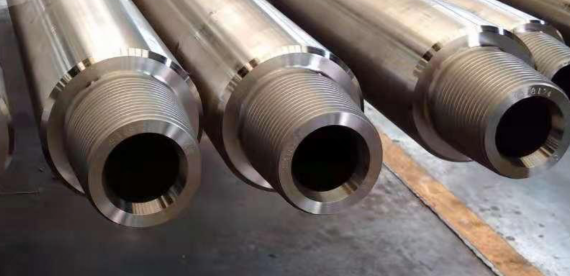
The drill collar is a thick-walled, heavy-duty steel tube located at the bottom of the drill string, above the drill bit. Its walls are extremely thick, and its unit length weighs four to six times as much as the drill pipe. It is the core component of the bottom hole assembly, acting as the "ballast" and "guide rod" of the entire drill string.

Drill Pipe vs. Drill Collar:
The Essential Difference between Functions and Roles:
Drill pipe is primarily used for drilling operations, lowering the drill bit into the well for drilling. Its primary function is to transmit torque and serve as a channel for drilling fluid, transmitting the rotary power of the surface rotary table to the drill collar and drill bit hundreds or even thousands of meters below.
The drill collar is primarily used in cementing operations, delivering cement or other cementing materials into the well. Its core function is to use its immense weight to exert downward pressure on the drill bit to break the rock. Furthermore, due to its high rigidity, it can effectively resist the natural deflection forces of the formation, helping to maintain the wellbore vertical or in the designed direction, and stabilizing the wellbore. It also protects the drill pipe by concentrating the complex bending stresses at the bottom onto itself, reducing fatigue damage to the upper drill pipe.
Metaphorically, if the drill string is like a train, the drill pipe is the long carriage and its connections, responsible for transportation and transmitting power. The drill collar is the heavy locomotive hanging at the front, using its weight to pull (actually press) the train behind it forward and determine its direction.
Differences in Appearance and Material:
The drill pipe body is a relatively thin steel pipe. To enhance the strength of the joints, it is thickened at both ends and welded with tool connectors. The outer diameter of these connectors is larger than the pipe body, forming a "dumbbell" shape with a thin center and thick ends. The ends have asymmetrical threads: one end is male, the other is female, allowing them to be directly connected one after another. To ensure efficient flow of drilling fluid, the drill pipe has a relatively large inner diameter.
The diameter of the drill collar is nearly uniform from the pipe body to the connector, with no noticeable thickness variations, giving it an overall symmetrical and robust appearance. This is due to the extremely thick wall thickness; to maximize weight and rigidity, there's no reason to reduce the pipe body to a thinner size. Both ends are typically male threads. A double-female coupling is used to connect them. This design simplifies the processing of the drill collar and improves joint strength. The drill collar has a small inner diameter, primarily to ensure minimal passage for drilling fluid while maintaining strength.
2. Material differences
Both drill pipe and drill collar materials are made of high-strength steel, but the specific steel selection, heat treatment, and performance requirements differ significantly. Drill collars are designed for overall high strength, hardness, and wear resistance, enabling them to penetrate rock and cut samples to collect geological information. Drill pipe, on the other hand, requires exceptional toughness and fatigue resistance, in addition to ultra-high strength, as it must withstand the extreme tensile, torsional, and impact forces during drilling.
Working Position and Assembly:
Drill Pipe: Located in the upper middle section of the drill string, it is made of seamless steel pipe with a thin wall thickness (typically 9-11mm). Joints are used at both ends to extend the drill string.
Drill Collar: Located at the very bottom of the drill string, it is the core component of the lower drill assembly (BHA). Its wall thickness is significantly thicker (typically 38-53mm, approximately 4-6 times that of the drill pipe), and it lacks independent joints. Both ends of the pipe are directly threaded.
The typical drill string configuration (from top to bottom) is:
Kelly Pipe→ Drill Pipe (hundreds of pieces) → Jars/MWD and other tools → Drill Collars (a dozen to several dozen pieces) → Drill Bit
This structure clearly demonstrates that:
The drill pipe is the main body and connection.
The drill collar is the pressure-inducing and stabilizing tool at the bottom.
Differences in Physical Structural Design:
Drill pipe needs to be "flexible": Because wellbores are not perfectly straight, drill pipe requires a certain degree of flexibility to adapt to wellbore curvature and avoid premature fatigue fracture under alternating stresses. Therefore, it is designed as a thin-walled tube.
Drill collars need to be "rigid": To effectively stabilize the wellbore, they must be sufficiently rigid and not easily bend. To provide sufficient weight, they must be heavy enough. Therefore, they are designed as thick-walled solid cylinders.
Conclusion:
Drill pipe and drill collars are partners with complementary functions. The drill pipe is responsible for "movement"—transmitting power and fluid; the drill collar is responsible for "stabilization"—providing stable pressure and direction. Both are indispensable, ensuring safe and efficient drilling operations.
Read more: Drill Pipe and Tool Joint Connection Method
Related information
